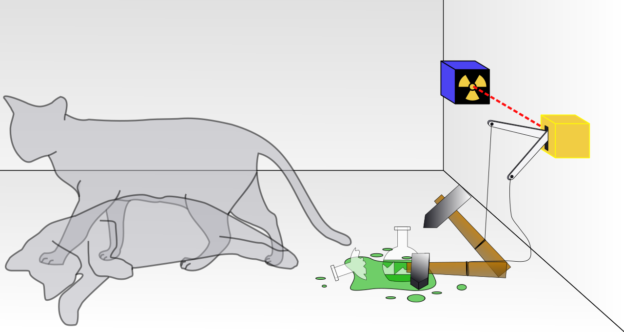That of Schrödinger’s cat is one of the most famous thought experiments of all time. Austrian physicist Erwin Schrödinger proposed it in 1935, as a way to demonstrate the absurdity of the so-called Copenhagen interpretation of quantum mechanics. In case you are not familiar with it, the idea is this: a cat is locked in a sealed box, that contains one atom of a radioactive material, a Geiger counter and a flask of a poisonous gas. If the atom decays (a random event), the Geiger counter detects it, and releases the poison, killing the cat. The sealed box prevents us from seeing what happens. The Copenhagen interpretation implies that, as long as it remains sealed, the cat-box-poison system exists in a state in which the cat is simultaneously alive and dead. On opening the box, we make the system “choose” a state in which the cat is 100% alive or 100% dead.
I have often thought of professor Schrödinger’s notorious animal when in the early stages of a new relationship. I’m sure it’s happened to you, too: you meet someone new. You find yourself intrigued, then fascinated, then spellbound with her or him. She or he seems interested, as well. The first date went well. The second even better. And yet, you are not sure. You could be reading the signs all wrong – you barely know the person, after all. You could be deceiving yourself. Like the observer outside the sealed box containing the cat, you just don’t know. So, you are simultaneously the luckiest person in the world, looking forward to a new love, and a dumb bastard headed for a heartbreak. Schrödinger’s love.
This situation is not unique to polyamory. But I find that polyamory enhances it, for two reasons. The first: it is harder to predict the success or failure of a polyamorous relationship than that of a monogamous one. Monogamy is a norm: there are dos and do nots, and they tend to apply to a wide array of people and circumstances. Furthermore, the norm is common knowledge: it is conveyed by art, popular culture, religion, politics and so on. Polyamory is networked: everything two people might be to each other depends not only on them, but on each of them’s relationships with their other lovers, and in turn with these other lovers’ relationships with their own lovers, and so on, across the One Love Graph.
The second reason for the persistence of new polyamorous relationships in a Schrödinger’s love state is that, all other things being equal, polyamorists take longer to get a new relationship started. Nearly always, there are calendar constraints: you need to accommodate your new sweetheart without penalizing your incumbent partners, and he or she has exactly the same problem. Quite often, poly folks also have doubts, struggle with insecurity or with a judgmental environment: one or both of you might need some extra time and patience. Polyamorists aspire to loving several people at the same time, in full transparence and consent. This is ambitious: we are bold in our life strategy. But this very boldness requires us to be prudent in tactics: small, incremental changes, re-assuring everyone at every step we take.
For these reasons, the superposed both-alive-and-dead state of your new romance is likely to last a fairly long time. This can be difficult. As Schrödinger’s lover, you are elated and crushed, happy in love and miserable and abandoned, all at the same time. Trust me – I’ve been there, more than once.
Fortunately, polyamorists tend to be good communicators – we have to, or we are headed for trouble. There are tools that we can deploy to open the damn box and make Schrödinger’s love alive or dead already: my favorite one is the S.T.A.R.S. talk. But they are tools, not magic wands. They work best when you need them least: when the minds of both you and your beloved(s) are clear and serene, and when you know yourselves well. No point insisting on a “clarifying talk” with someone who is still confused, scared, locked in a struggle with her or his feelings. You will clarify nothing, and alienate and scare further the person you are trying to bond with. And anyway, if you care for someone, forcing her or him to adjust to your own timetable is a lousy way to show it.
In the end, there is not much you can do, except trust your beloved(s), and accept to take things at the pace of the slowest, most confused person in the relationship. Mistakes will happen, and ambiguous messages will be sent that can have a hurtful interpretation: I find it helps to assume the other’s good faith rather than take offense. In fact, these small misunderstandings can help move things in the right direction, because you can quickly ask the other to clarify them. Every time an ambiguous communication gets resolved for the better, your mutual trust grows. For the same reason, I try to offer explanations for anything that I say that might sound ambiguous. There is a risk of overexplaining, but that is not as scary as the risk of unintentionally hurting someone you care for.
So: as a polyamorist exploring a new love, you should brace for a long Schrödinger’s love phase. You can’t avoid it, so try to enjoy/endure it. Polyamory is definitely not for the faint of heart. But we already knew that.
Image credit: Dhatfield – Own work, CC BY-SA 3.0, https://commons.wikimedia.org/w/index.php?curid=4279886
